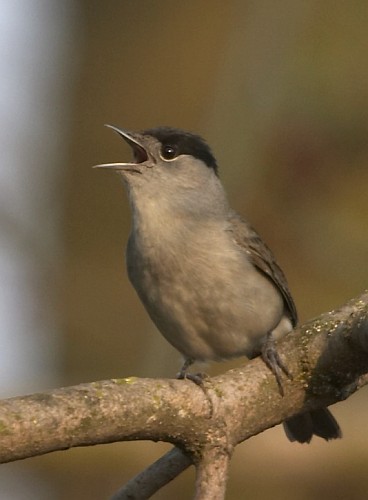| New Photos | Animal News | Animal Sounds | Animal Movies | Upload Photo | Copyright | Korean |
|---|
| Funny Animal Photos | Monsters in Animalia | Wiki Articles Fun Facts about Animals | Links | Home | Mobile A.P.A. |
|---|
| Image Info | Original File Name: Blackcap (Sylvia atricapilla)_male_2.jpg Resolution: 368x500 File Size: 31220 Bytes Upload Time: 2007:11:01 10:14:01 | |
| Author | Name (E-mail): Unknown | |
| Subject | Blackcap (Sylvia atricapilla) - Wiki | |
 |
| Email : E-Card | Poster | Web Master Delete Edit Info Admin |
| Description | Blackcap (Sylvia atricapilla) - Wiki
Blackcap
The Blackcap, Sylvia atricapilla, is a common and widespread sylviid warbler which breeds throughout northern and temperate Europe. Its color pattern is unique in the genus Sylvia; the Blackcap's closest living relative is the Garden Warbler which looks different but has very similar vocalizations. These two, whose ranges extend farther northeastwards than other Sylvia, seem to form sister species well distinct from the other typical warblers (Helbig 2001, Jønsson & Fjelds?? 2006). It is a robust typical warbler, mainly grey in plumage. Like most Sylvia species, it has distinct male and female plumages: The male has the small black cap from which the species gets its name, whereas in the female the cap is light brown. This is a bird of shady woodlands with ground cover for nesting. The nest is built in a low shrub, and 3???6 eggs are laid. The song is a pleasant chattering with some clearer notes like a Blackbird. This full song can be confused with that of the Garden Warbler, but in the Blackcap, it characteristically ends with an emphatic fluting warble. Especially in isolated Blackcap populations (such as in valleys or on peninsulas and small islands), a simplified song can occur. This song is said to have a Leiern-type ("drawling") ending after the term used by German ornithologists who first described it. The introduction is like that in other Blackcaps, but the final warbling part is a simple alteration between two notes, as in a Great Tit's call but more fluting (Snow et al. 1998). One subspecies of the Blackcap, S. a. heineken, is very prone to melanism. Its exact extent of occurrence is not altogether clear; it is typically found on Madeira but might inhabit all Macaronesian islands as well as the Atlantic coasts of Iberia and Northwest Africa (Snow et al. 1998). The melanistic birds, S. a. heineken morpha obscura, were at first considered a distinct subspecies. This small passerine bird is migratory, and northern and central European breeders winter in southern Europe and north Africa where the local populations are resident. It is hardier than most warblers, partly because it will readily eat small berries as well as the more typical warbler diet of insects. In recent years, substantial numbers of central European birds have taken to wintering in gardens in southern England. Presumably the ready availability of food, particularly from bird tables, and the avoidance of migration over the Alps compensate for the sub-optimal climate. Bearhop et al. (2005) reported that birds wintering in England tend to mate only among themselves, and not usually with those wintering in the Mediterranean. This is because the short-distance migrants arrive back from the wintering grounds for breeding earlier than birds wintering around the Mediterranean, and of course have spent the winter together, when pair-bonds are initiated. The authors point out that division of a population by different migration routes can be a first step towards speciation. Cultural references The presence and sounds of this bird have since long inspired Italian writers. "La Capinera" (Italian for Blackcap) is the title of one of the most famous poems by Giovanni Pascoli. Storia di una capinera is a 1993 movie directed by Franco Zeffirelli and distributed with the international title "Sparrow". The Blackcap's call symbolises St Francis in Messiaen's opera, Saint-Fran??ois d'Assise. http://en.wikipedia.org/wiki/Blackcap
| |||
| Copyright Info | AnimmalPicturesArchive.com does not have the copyright for this image. This photograph or artwork is copyright by the photographer or the original artist. If you are to use this photograph, please contact the copyright owner or the poster. |
|
|
|
| |||||||
| CopyLeft © since 1995, Animal Pictures Archive. All rights may be reserved. | ||||||||
Stats